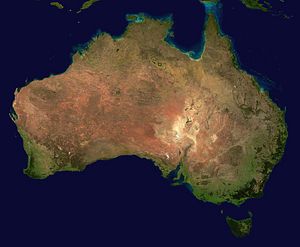According to archaeologists, humans arrived in Australia around 50,000 years ago. This is about 10,000 earlier than previously thought. By around 49,000 years ago, people were living in the arid interior of the continent, evidence of significant technological skills and social cohesion. Previously, the oldest sites containing human habitation in the arid portions of Australia were from around 38,000 years ago.
DNA evidence suggests that the ancestors of the Australian Aborigines split from Eurasian (Central and South Asian) rather than East Asian populations somewhere between 60,000 and 50,000 years ago. They arrived in northern Australia 50,000 years ago and within the span of just a thousand years, made it to South Australia, a very rapid expansion. This swift spread was probably assisted by the initial lack of competition from other human groups and easy hunting, as the animals of Australia were not used to this new predator.
In an article published in the journal Nature, researchers lay out evidence of human activity at Warratyi rock shelter in the Flinders Ranges in South Australia. Among the things found at the site were burnt eggshells, stone tools, and a bone from a now-extinct creature that resembled a huge wombat-like marsupial. Additionally, numerous bone tools, as well as dyes–red ochre and gypsum pigments–have been discovered.
Stone tools have been used by people for hundreds of thousands of years, but bone tools are a relatively new invention. The fact that early people in Australia were using them around the same time people in Europe and Asia were also just developing such tools is evidence of a degree of innovation and local technological development, according to the lead author of the paper, Giles Hamm.
One of the main questions raised by the findings as well as previous research is whether the arrival of humans in Australia is linked to a mass extinction of megafauna (large animals) around the same time, or if this was caused by climate change. While it was unclear if humans developed the tools to take giant animals by this time, the discovery of the wombat-like creature at Warratyi rock shelter seems to prove that they did. The creature, which weighed 6,000 pounds, is unlikely to have climbed up to the rock shelter by itself, making it likely that humans brought its body (or bones) there.
While the jury is still out on what caused the extinction of Australia’s ancient megafauna, it is clear that human beings were interacting with these animals 49,000 years ago. Technologically advanced people had spread throughout Australia with amazing rapidity, while humans were still trying to move into other parts of the world, blocked by weather or other human species.

































